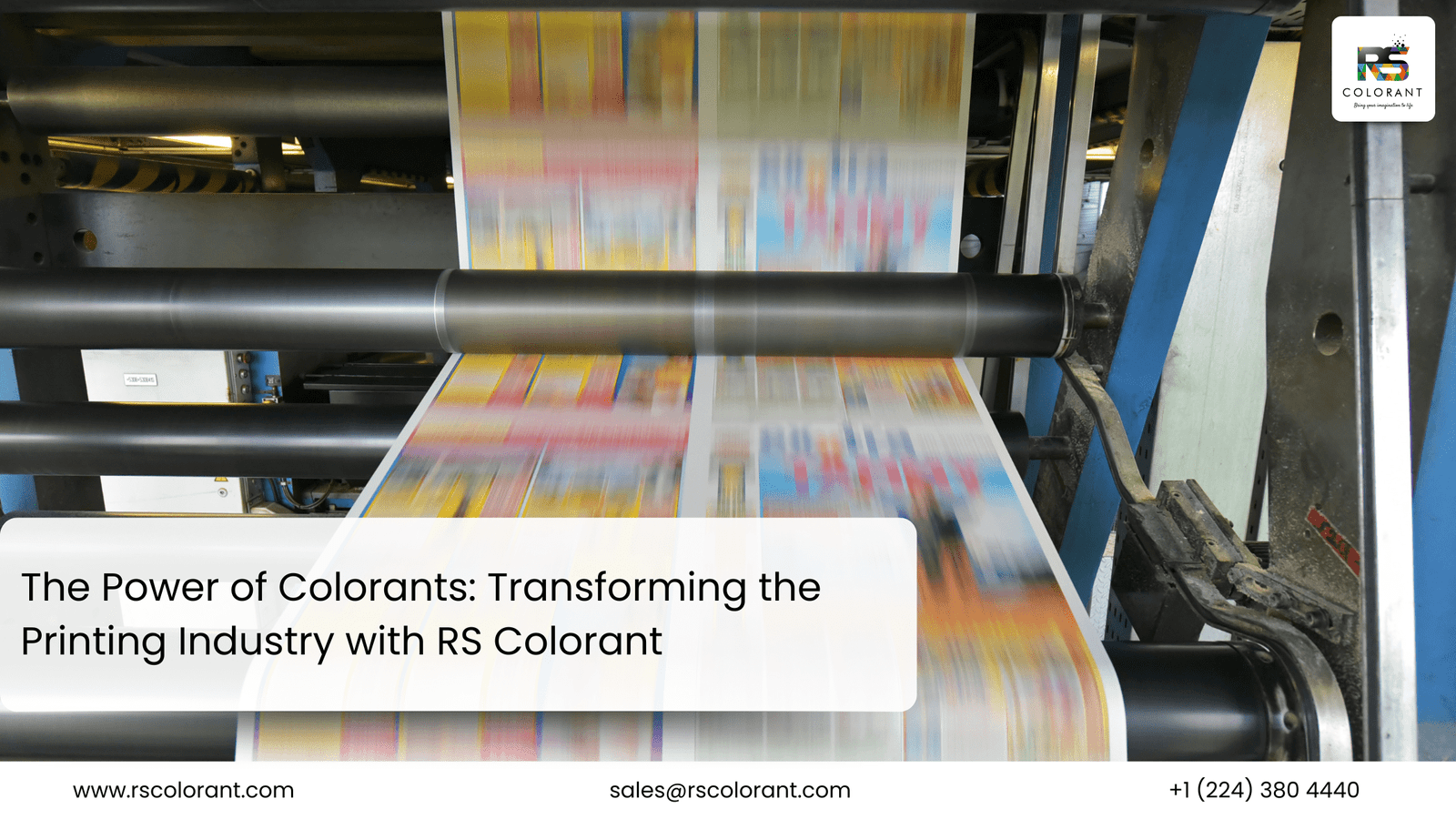The Vital Role of Colorants in the Printing Industry
The world of printing thrives on vibrant colors, captivating visuals, and the ability to bring ideas to life on paper, fabric, or plastic. Behind this visual feast lies the unsung hero: the colorant. These remarkable materials play a critical role in the printing industry, influencing everything from aesthetics to functionality.
This article delves into the fascinating world of colorants in printing, exploring their types, properties, and applications. We’ll also discuss the evolving needs of the printing industry and how RS Colorant is at the forefront of providing high-quality color solutions.
Unveiling the World of Colorants: Pigments vs. Dyes
Colorants come in two main categories: pigments and dyes. Understanding their differences is crucial for selecting the appropriate solution for your printing needs.
Pigments:
- Insoluble: Pigments are finely ground particles that remain suspended within the printing ink. They don’t dissolve in the ink base.
- Opacity: Pigments offer excellent opacity, making them ideal for achieving solid, opaque colors and covering underlying surfaces.
- Lightfastness: Pigments generally boast superior lightfastness, meaning they resist fading from exposure to light, making them perfect for applications requiring long-lasting color vibrancy.
- Applications: Pigments are widely used in various printing applications, including offset printing, flexography, gravure printing, and screen printing. They are particularly well-suited for high-quality printing projects like brochures, packaging materials, magazines, and signage.
Dyes:
- Soluble: Dyes readily dissolve in the printing ink, becoming part of the ink solution itself.
- Transparency: Dyes offer transparency, allowing the underlying surface to show through to some degree. This is advantageous for creating vibrant, translucent effects.
- Lightfastness: Lightfastness can vary with dyes, with some offering excellent resistance and others prone to fading.
- Applications: Dyes are commonly used in inkjet printing and some types of flexographic printing. They excel in creating high-resolution images and graphics on various substrates, including paper, textiles, and plastics.
Choosing the Right Colorant:
The selection of the ideal colorant hinges on several factors, including:
- Desired Color: The specific color palette you want to achieve. Pigments offer a wider range of opaque colors, while dyes can produce vibrant translucent effects.
- Printing Method: Different printing methods favor specific colorant types. Pigments are more suitable for offset printing, while dyes excel in inkjet applications.
- Substrate: The material you’ll be printing on. Pigments generally offer good adhesion to various substrates, while the suitability of dyes depends on the specific material.
- Lightfastness Requirements: How long the printed materials need to retain their color vibrancy will guide your choice. Pigments usually offer better lightfastness.
Properties of Effective Colorants for Printing
Beyond categorization, good printing colorants should possess specific properties to ensure high-quality results.
- High Tinting Strength: A colorant with high tinting strength requires less material to achieve a desired color intensity, leading to cost-efficiency.
- Dispersibility: The ability of the colorant to disperse evenly throughout the ink base prevents clumping or settling, ensuring consistent color throughout the printing process.
- Chemical Resistance: Printing inks encounter various environments, so colorants need to be resistant to chemicals such as solvents, acids, or alkalis, for long-lasting color performance.
- Heat Stability: Colorants must maintain their integrity during the printing process, which can involve heat generation.
A Spectrum of Printing Applications
Colorants empower a diverse range of printed materials, each with specific requirements:
- Packaging Printing: Packaging relies heavily on colorants to create visually appealing designs that grab attention and communicate brand identity. Pigments are often chosen for their opacity and lightfastness, ensuring long-lasting appeal on store shelves.
- Publication Printing: Magazines, brochures, and flyers utilize colorants for vivid imagery and graphics to capture readers’ attention. Both pigments and dyes can be used here, depending on the desired level of opacity and the printing method.
- Textile Printing: Colorants breathe life into fabrics, creating vibrant patterns and designs for clothing, sportswear, and home décor. Dyes are often preferred in textile printing for their ability to penetrate the fabric fibers and produce clear, detailed prints.
- Label Printing: Product labels require colorants for clear, legible text and eye-catching visuals. Both pigments and dyes may be used depending on the type of label and desired level of durability.
The Evolving Landscape of Printing and Colorants
The printing industry is constantly evolving, embracing new technologies and trends. Colorants must adapt to meet these changing demands.
Sustainability: A Growing Imperative
Environmental consciousness is increasingly critical. Consumers, businesses, and governments are demanding more sustainable practices across all industries, including printing. Colorants play a significant role in this shift.
- Eco-friendly Colorants: The development of colorants with reduced environmental impact is a top priority. This includes using non-toxic materials, minimizing waste, and reducing water consumption during the manufacturing process.
- Water-Based Inks: The adoption of water-based inks is gaining traction as they reduce the use of volatile organic compounds (VOCs) and other harmful chemicals. Colorants for these inks must be specifically formulated to provide excellent performance in water-based systems.
- Recyclability: Colorants that facilitate the recyclability of printed materials are essential for a circular economy. Research is focused on developing colorants that don’t hinder the recycling process.
Digital Printing and Colorants
Digital printing has revolutionized the industry, offering greater flexibility, shorter turnaround times, and personalized printing capabilities. Colorants for digital printing have specific requirements.
- Inkjet Inks: Inkjet printing uses specialized inks that rely on dyes or pigment-based formulations. Colorants for inkjet inks must offer excellent color gamut, fast drying times, and compatibility with various substrates.
- Color Management: Achieving accurate color reproduction across different digital printing technologies is crucial. Colorants must be formulated to ensure consistent color output.
- On-Demand Printing: The ability to produce small quantities of printed materials on demand requires colorants that can be efficiently used in variable data printing applications.
Advanced Colorants and Special Effects
Consumers crave unique and visually appealing printed materials. Colorants are at the forefront of delivering innovative effects.
- Fluorescent and Metallic Colorants: These colorants add vibrancy and visual interest to printed materials, enhancing brand visibility and product appeal.
- Special Effect Colorants: Colorants can create various special effects, such as pearlescent, iridescent, and holographic finishes, elevating the visual impact of printed products.
- Color Matching Technology: Advancements in color matching technology enable precise color reproduction, ensuring consistency across different printing jobs and materials.
The Role of RS Colorant
RS Colorant is committed to meeting the evolving needs of the printing industry. By offering high-quality, innovative colorants, RS Colorant empowers printers to achieve exceptional results while prioritizing sustainability and performance.
- Custom Color Solutions: RS Colorant works closely with customers to develop customized colorant formulations that meet specific requirements, ensuring precise color matching and optimal performance.
- Technical Expertise: The company’s team of experts provides technical support and guidance to help printers select the right colorants for their applications and overcome challenges.
- Sustainability Focus: RS Colorant is dedicated to developing sustainable colorant solutions that minimize environmental impact without compromising performance.
Conclusion
Colorants are the backbone of the printing industry, enabling the creation of stunning visuals and functional materials. The ongoing evolution of printing technologies and consumer preferences drives the need for innovative and sustainable colorant solutions. RS Colorant, with its commitment to quality, innovation, and sustainability, is well-positioned to meet the industry’s challenges and opportunities.




